ASUS P5N-E SLI: NVIDIA's 650i enters with a Bang
by Gary Key on December 22, 2006 5:00 AM EST- Posted in
- Motherboards
Standard Gaming Performance
As usual, gaming performance was tested with a variety of current games. We ran benchmarks with our standard 1280x1024 resolution without antialiasing enabled (and generally without anisotropic filtering, though that varies by game). Given the number of users that run 19 inch LCDs these days, 1280x1024 represents one of the most commonly used resolutions. We could certainly increase the amount of eye candy being displayed in most of the games, but as this is a motherboard benchmark we aren't particularly interested in maxing out the graphics cards in our tests.
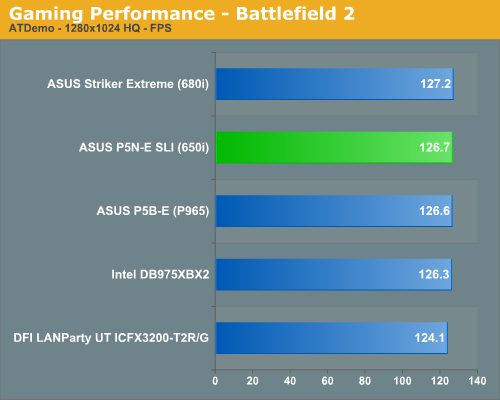
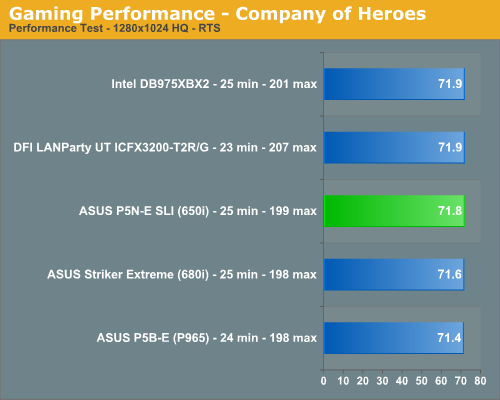
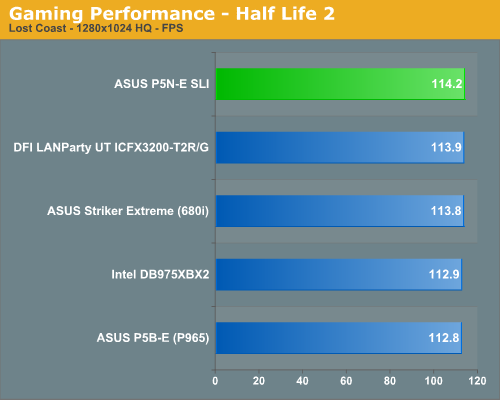

These results surprised us but after testing several other games we came to the same conclusion, the ASUS P5N-E SLI performs extremely well in our game benchmarks where graphics subsystem optimizations are very important. The board was very stable with our settings and did not have any issues during benchmarking or online game play. However, this board was ultra sensitive to memory changes when testing games. Although we could dial in higher memory speeds or lower latencies and still pass the synthetic tests, we would notice instant lockups in games with the same settings. We received a retail Intel DB975XBX2 board that performed slightly better than our press kit sample during testing and will update these scores in our next RD600 article. While the performance improved, especially in CrossFire operation, it did not improve enough to top the 650i board.
High-Resolution Gaming Performance
For high-quality gaming performance, we also tested at 1600x1200 and 1920x1200 with 4xAA /8xAF. As just about anyone familiar with current games can tell you, benchmarking with most single high-end graphics card at those stressful settings will make just about any recent game GPU limited. In fact, several of the most recently released games such as Oblivion can be GPU limited at this setting even with CrossFire or SLI setups. However, our testing will utilize the GeForce 8800 GTX and unfortunately, the two games we listed do not benefit that much from SLI. This is due to both our processor choice and the fact the current drivers still need additional SLI optimizations. In fact we did not see any real differences in performance in Q4 or Battlefield 2 with SLI enabled. Our initial testing with Oblivion did show improvements but we still believe our 8800 GTX SLI combination was CPU limited in most of our tests.
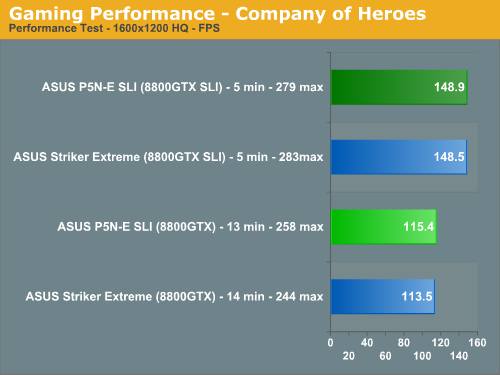
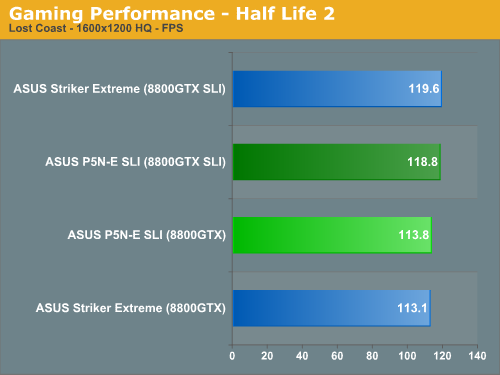
We had heard rumors that the 8800 GTX cards would thrive on the dual x16 capable 680i chipset but in looking at the results in our two test games it appears there is very little difference in the scores between the two nForce 600i boards. We did not have any issues running our 8800 GTX SLI setup on the dual x8 capable 650i board and only in the synthetic 3DMark benchmarks did we see any true separation between the two setups. Those results favored the 680i over the 650i by 8% in 3DMark06, 6% in 3DMark05, and in 3DMark 2001 the 650i actually finished about 4% ahead of the 680i. At this time, the current games we have tested will perform almost equally on either board in 8800 GTX SLI operation at 1600x1200. We also tested at 1920x1200 resolutions with the same results between the two chipsets. We still need to complete testing at 2560x1600 with the 650i chipset but considering the very small increase in performance in SLI mode with our test setup, we highly recommend the purchase of a single 8800 GTX for today's games and to forgo 8800 GTX SLI operation at this time.
As usual, gaming performance was tested with a variety of current games. We ran benchmarks with our standard 1280x1024 resolution without antialiasing enabled (and generally without anisotropic filtering, though that varies by game). Given the number of users that run 19 inch LCDs these days, 1280x1024 represents one of the most commonly used resolutions. We could certainly increase the amount of eye candy being displayed in most of the games, but as this is a motherboard benchmark we aren't particularly interested in maxing out the graphics cards in our tests.




These results surprised us but after testing several other games we came to the same conclusion, the ASUS P5N-E SLI performs extremely well in our game benchmarks where graphics subsystem optimizations are very important. The board was very stable with our settings and did not have any issues during benchmarking or online game play. However, this board was ultra sensitive to memory changes when testing games. Although we could dial in higher memory speeds or lower latencies and still pass the synthetic tests, we would notice instant lockups in games with the same settings. We received a retail Intel DB975XBX2 board that performed slightly better than our press kit sample during testing and will update these scores in our next RD600 article. While the performance improved, especially in CrossFire operation, it did not improve enough to top the 650i board.
High-Resolution Gaming Performance
For high-quality gaming performance, we also tested at 1600x1200 and 1920x1200 with 4xAA /8xAF. As just about anyone familiar with current games can tell you, benchmarking with most single high-end graphics card at those stressful settings will make just about any recent game GPU limited. In fact, several of the most recently released games such as Oblivion can be GPU limited at this setting even with CrossFire or SLI setups. However, our testing will utilize the GeForce 8800 GTX and unfortunately, the two games we listed do not benefit that much from SLI. This is due to both our processor choice and the fact the current drivers still need additional SLI optimizations. In fact we did not see any real differences in performance in Q4 or Battlefield 2 with SLI enabled. Our initial testing with Oblivion did show improvements but we still believe our 8800 GTX SLI combination was CPU limited in most of our tests.


We had heard rumors that the 8800 GTX cards would thrive on the dual x16 capable 680i chipset but in looking at the results in our two test games it appears there is very little difference in the scores between the two nForce 600i boards. We did not have any issues running our 8800 GTX SLI setup on the dual x8 capable 650i board and only in the synthetic 3DMark benchmarks did we see any true separation between the two setups. Those results favored the 680i over the 650i by 8% in 3DMark06, 6% in 3DMark05, and in 3DMark 2001 the 650i actually finished about 4% ahead of the 680i. At this time, the current games we have tested will perform almost equally on either board in 8800 GTX SLI operation at 1600x1200. We also tested at 1920x1200 resolutions with the same results between the two chipsets. We still need to complete testing at 2560x1600 with the 650i chipset but considering the very small increase in performance in SLI mode with our test setup, we highly recommend the purchase of a single 8800 GTX for today's games and to forgo 8800 GTX SLI operation at this time.










27 Comments
View All Comments
JarredWalton - Monday, December 25, 2006 - link
The big problem with AGP is that it only allowed for one high-speed port. PCIe allows for many more (depending on chipset), plus you get high up and down bandwidth, whereas AGP had fast writes (CPU to card) but slow reads (card to CPU). X8 PCIe is still at least as fast as 8X AGP in terms of bandwidth, and in most instances we aren't stressing that level of bandwidth.Lord Evermore - Monday, December 25, 2006 - link
x8 PCIe can be as slow as AGP4X depending on the traffic pattern. 4 lanes of PCIe (or 8 half-lanes technically; the number of lanes in each direction in x8) is 1GBps, AGP4X is 1.066GBps. So if most of the data were being streamed in one direction, those two would be equivalent, theoretically. AGP8X would have 2.13GBps in which to stream that uni-directional data. If half the data were going in each direction, then x8 PCIe would be equivalent to AGP8X since they'd both have 1GBps available for each direction, or 2GBps half the time for AGP actually (though performance might be lower with AGP because of the non-independent half-duplex nature).But since AGP4X is probably still capable of handling the majority of applications, it doesn't really matter much.
Too bad we can't manually control the number of lanes in use to a particular slot. It would be very interesting to compare performance using the same graphics card on the same mainboard using x1, which could depending on the pattern be about equal to a simple PCI card or AGP1X, to x2, x4, x8 and x16 (since x16 can in some cases be comparable to AGP8X). That would help to definitively say whether all the increased bandwidth is actually making a difference, or if other factors are involved.
Lord Evermore - Monday, December 25, 2006 - link
AGP 3.0 supports multiple slots depending on what the chipset is designed to support. According to Wikipedia, HP AlphaServer GS1280 has up to 16 AGP slots. Those basically all connect to a single interface on the chipset. It's likely that since it's a part of the AGP3 spec, every chipset could have supported multiple ports, but normal mainboard makers never used it. There were probably reasons that it wouldn't have worked well for an SLI type feature, possibly the read/write bandwidth issue.Any chipset designer also could have just put in multiple AGP interfaces I bet, even if they only supported one card a time. Don't know what effect that would have on bandwidth or contention for access to the CPU. The cards probably also would have not been able to work in any sort of SLI configuration where the data had to go over the chipset bus.
PrinceGaz - Friday, December 22, 2006 - link
Your article starts with questions about this, and they remain unresolved at least up until nForce4 chipsets to my knowledge (because I have one). Of course I'm not stupid enough to risk using nVidia's hardware firewall and associated drivers, but even their IDE drivers can cause a normal installation of Windows XP to have trouble starting which means I cannot safely enable NCQ (I have a dual-core processor) or even benefit from any acceleration the nForce4 chipset might provide, because the nVidia drivers are unstable.I once used to trust nVidia, especially with drivers back in the early GeForce days, but the latest official GeForce drivers have been bug-ridden what with incorrect monitor refresh-rate detection (even after using the .inf file), and stupidity like doubling the reported memory clock speed of the card when it had always previously been correct.
Their good graphics-card drivers were why I bought an nForce4 based board, and also on this site's recommendation, and I must admit I'm only so-so about it. It works and does everything it says it should on the box, but the computer doesn't feel as responsive as it should and I suspect that is partly because I had to revert to the default Microsoft disk drivers.
All reviews of nVidia chipset motherboards should include a mention about their driver issues (bugs) until they are fixed. Just because you test a mobo for one day and it seems to work and overclock to a given level, does not mean it can be trusted day-in day-out. If you cannot install the IDE drivers, then NCQ and other hard-drive features are negated. If the hardware firewall drivers are so bad no one with any sense goes near them, then that hardware in the chipset is worthless and could best be described as a liability.
I like this site, but it would be nice if you sometimes looked back on products you've been given earlier in the year and report on whether they actually lived up to expectations. Assuming you get to keep any of your stuff. If you don't, then the opinions of the writers becomes almost meaningless because anything looks good for a day or two.
Tanclearas - Saturday, December 23, 2006 - link
Gary Key should be sensitive to this issue more than anyone. Gary tried to facilitate contact between me and Nvidia to try to nail down the cause of the hardware firewall corruption issues. He contacted Nvidia several times for me, and I was contacted by an Nvidia rep twice. I provided the Nvidia rep with detailed steps that I had used to install Windows and the drivers. I conducted tests without any software installed, and continually experienced issues. I provided screen shots of errors to the rep as well. I offered to install Windows and drivers of any version they requested, using whatever steps they wanted.After providing them with all of the details and making that offer, Nvidia never contacted me again. Gary followed up with me, and contacted Nvidia again on my behalf to try to get them to get in touch with me. Ultimately, they just removed official support for the firewall. I am honestly surprised a class action suit never came of it. Nvidia used the hardware firewall as a selling feature, then made no attempt to solve the issues that were being experienced by many users, and finally just pulled the plug on it.
Anyway, I too have little faith in Nvidia actually taking the issues seriously and finding a solution. I'm not going to say that I'll never buy a board with an Nvidia chipset again, but I can guarantee I won't be buying 680/650 when there are already known issues, and any future board based on an Nvidia chipset will have to go through months of retail availability and positive user feedback before I'd be willing to try again.
LoneWolf15 - Tuesday, December 26, 2006 - link
Insightful post. I'm still using an nForce 4 Ultra chipset board (MSI 7125 K8N Neo4 Platinum), and it's been good for me, but I've never used their firewall software after hearing reports from others.The current 680i issues have led me to the same conclusion as you: I have no interest in buying an nVidia chipset mainboard next time around (so far, Intel's i975X seems to be the only one I'd be interested in). It seems nVidia has a history of sweeping troubles (i.e., this issue, first-generation PureVideo fiascos with the NV40/45 graphics chipsets that I'm surprised never caused a class-action, the nForce3 250Gb firewall that didn't provide the acceleration they first claimed it did) under the rug if they cannot resolve them through software fixes, and hope nobody raises enough of a ruckus (a method which seems to have worked well for them).
I've just bought a new Geforce graphics card, but experiencing the PureVideo issues alone caused me to skip to ATI for two generations. It's also taught me to read forums with additional user experiences of a product for the first month after release, before I purchase. It seems review sites often miss driver issues/bugs in first-rev. hardware, due to limited time envelopes for review, or not being able to test with as wide a variety of hardware as the community (admittedly, not their fault). I'm not willing to pay the early-adopter/rev 0.9 price any more.
KeypoX - Saturday, December 23, 2006 - link
anyone notice how low quality these articles have become? A couple years ago this site was a decent place to get some info but now ...Please go back to the old good qual cause now you guys are not good at all ... i feel pretty sad everytime i visit the site
Xcom1Cheetah - Friday, December 22, 2006 - link
Was just wandering isn't the power numbers of idle and full load are a little to high for the stability of the system.. i m not sure but i feel the higher power is going to reduce the stability of the over clock in the longer run...Performance and feature wise it look pretty ideal to me.. only if its power number has been inline with P965.
Any chance that these power number coming down due to the BIOS fix/update.?
JarredWalton - Friday, December 22, 2006 - link
I doubt the power req's will drop much at all over time. However, higher power draw doesn't necessarily mean less stable. It does mean you usually need more cooling, but a lot of it is simply a factor of the chipset design. I'm pretty sure 650i is a 90nm process technology, but for whatever reason NVIDIA has always made chips that run hot. The Pentium 4 wasn't less stable because it used more power, though, and neither is the nForce series.Perhaps part of the cause of the high power is that NVIDIA uses HyperTransport as well as the Intel FSB architecture. Then having two chips that run hot.... Added circuitry to go from one to the other? I don't know. Still, the ~40W power difference is pretty amazing (in a bad way).
Avalon - Friday, December 22, 2006 - link
For $130, that's a pretty good looking board. I was expecting the 650SLI chipset based boards to be more around $150-$175. Now this makes me curious as to how 650Ultra will pan out.